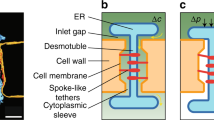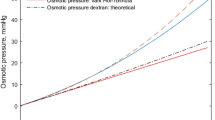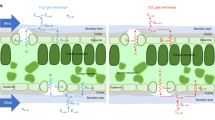Abstract
IT has recently been suggested by several workers1 that the plasmalemma of the plant cell does not constitute a barrier to the diffusion of ions, and that there is a Donnan distribution of ions between the cytoplasm of the plant cell and the extracellular medium. As a corollary, it has been suggested1c that the electric resistance and capacity of plant tissue are to be attributed wholly to the properties of the tonoplast and bulk cytoplasm. However, it has been suggested that recent measurements of resistance and capacity on Nitella give the properties of the plasmalemma2; and a.c. measurements on Chlorella3, which has no significant vacuole, appear to require a similar explanation. Results which I have obtained with cells of Nitella indicate that the plasmalemma of the Nitella cell acts as a barrier to the inward diffusion of calcium ions, and is responsible for the d.c. resistance of the cell bathed in a solution of potassium, sodium or calcium chloride. Thus if the cytoplasm contributes to the apparent free space for ionic diffusion, it cannot be in the simple way proposed for higher plant tissue1. Although one cannot argue from single cells of an alga to pieces of angiosperm tissue, it may be noted that there is evidence from Nitella that labelled ions do cross the plasmalemma much more rapidly than the tonoplast4; this situation is comparable with that in angiosperm tissue1c.
This is a preview of subscription content, access via your institution
Access options
Subscribe to this journal
Receive 51 print issues and online access
$199.00 per year
only $3.90 per issue
Buy this article
- Purchase on Springer Link
- Instant access to full article PDF
Prices may be subject to local taxes which are calculated during checkout
Similar content being viewed by others
References
(a) Vervelde, G. J., “Zoutophoping door Plantenwortels” (Veenman, Wageningen, 1952). (b) Butler, G. W., Physiol. Plantarum, 6, 662 (1953). (c) Hope, A. B., and Robertson, R. N., Aust. J. Sci., 15, 197 (1953). (d) Hope, A. B., and Robertson, R. N., Nature, 177, 43 (1956).
Bennett, M. C., and Rideal, Sir Eric, Proc. Roy. Soc., B, 142, 483 (1954).
Hope, A. B., Austral. J. Biol. Sci., 9, 53 (1956).
Brooks, S. C., J. Cell Comp. Physiol., 38, 83 (1951).
Walker, N. A., Austral. J. Biol. Sci., 8, 476 (1955).
Blinks, L. R., J. Gen. Physiol., 13, 495 (1930).
Gelfan, S., Protoplasma, 4, 192 (1928).
Author information
Authors and Affiliations
Rights and permissions
About this article
Cite this article
WALKER, N. Ion Permeability of the Plasmalemma of the Plant Cell. Nature 180, 94–95 (1957). https://doi.org/10.1038/180094a0
Issue Date:
DOI: https://doi.org/10.1038/180094a0
This article is cited by
-
The excitability of plant cells: With a special emphasis on characean internodal cells
The Botanical Review (1994)
-
The relative electrical resistances of the plasmalemma and tonoplast in higher plants
Planta (1966)
-
Durch Elektrolytverschiebungen im Zellinnern ausgelöste Veränderungen der elektrischen Spannung am Plasmalemma vonNitella mucronata
Protoplasma (1960)
-
Ion Permeability of the Plasmalemma of the Plant Cell
Nature (1958)
-
Ion Permeability of the Plasmalemma of the Plant Cell
Nature (1957)
Comments
By submitting a comment you agree to abide by our Terms and Community Guidelines. If you find something abusive or that does not comply with our terms or guidelines please flag it as inappropriate.



